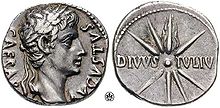Coinage reform of Augustus
The coinage reform of Augustus refers to the reform of Roman currency undertaken by Augustus in 23 BC.
The reform[]
Augustus brought the minting of gold and silver coins, the aureus and denarius, under his personal control without changing their weight or fineness. The gold aureus, weighing about one-quarter ounce, was worth twenty-five silver denarii, weighing about one-eighth of a troy ounce.[1]
Augustus more comprehensively reformed denominations below the denarius. New ratios were fixed among the currencies: the sestertius was now minted from about an ounce of orichalcum, an alloy of copper and zinc, rather than silver, and fixed at a quarter of a denarius. The dupondius, formerly a two-pound bronze coin, was now orichalcum, valued at half a sestertius and weighing half as much. The half-ounce as, worth half a dupondius, the semis, worth half an as, and the quadrans, worth half a semis, were the first pure copper coins minted in Rome since 84 BC.[2]
References[]
- ^ Cartwright, Mark. "Roman Coinage". World History Encyclopedia. Retrieved 21 April 2016.
- ^ Crawford, Michael. Coinage and Money Under the Roman Republic: Italy and the Mediterranean Economy. pp. 257–258, 260.
- Coins of ancient Rome
- Augustus
- Ancient Rome stubs
